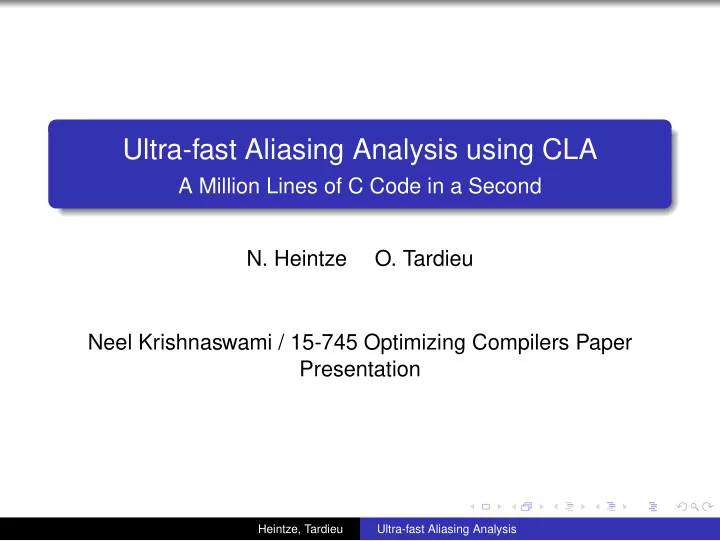

Ultra-fast Aliasing Analysis using CLA A Million Lines of C Code in a Second N. Heintze O. Tardieu Neel Krishnaswami / 15-745 Optimizing Compilers Paper Presentation Heintze, Tardieu Ultra-fast Aliasing Analysis
The Problem Large (1+ MLoc) code base in C Programmer changes variable or struct type What else should be updated for “type-consistency”? Heintze, Tardieu Ultra-fast Aliasing Analysis
Partial Solution (1) – Typechecking Typechecking doesn’t work Casts make C’s type system unsound True dependencies get lost Heintze, Tardieu Ultra-fast Aliasing Analysis
Partial Solution (1) – Typechecking void foo(int tag, void *data) { switch(tag) { case CHAR: bar((char*) data); break; case NUM: baz((short*) data); break; } } int main(...) { short* data = f(); foo(NUM, (void*) data); } Heintze, Tardieu Ultra-fast Aliasing Analysis
Partial Solution (1) – Typechecking void foo(int tag, void *data) { switch(tag) { case CHAR: bar((char*) data); break; case NUM: baz((short*) data); break; } } int main(...) { long* data = f(); foo(NUM, (void*) data); } Heintze, Tardieu Ultra-fast Aliasing Analysis
Partial Solution (2) – Data Dependency Graphs Variable x depends on y if a change in y ’s value could change x ’s value. x := y + 5 // x depends on y u := x * v // u depends on x, v Can we compute a dependency graph of the program variables? Heintze, Tardieu Ultra-fast Aliasing Analysis
Problems with Data Dependency Graphs The C code: *x = y + 5; has the IR: H[x] := y + 5 Heap H is (conceptually) a variable 1 Every pointer update modifies the heap 2 Analysis uselessly conservative 3 Heintze, Tardieu Ultra-fast Aliasing Analysis
Partial Solution (3) – Points-to Analysis Flow-insensitive, context-insensitive points-to analysis: Model the heap H as a set of abstract locations (usually 1 program expressions). Model the program P as a set of assignment statements 2 Compute the transitive closure for each assignment 3 x → & y x → & y (if ⋆ x = e in P) (if e = ⋆ x in P) y → e e → y e 1 → e 2 e 2 → e 3 e 1 → e 2 (if e 1 = e 2 in P) e 1 → e 3 Heintze, Tardieu Ultra-fast Aliasing Analysis
Problems with Points-to Analysis Program has O ( n ) abstract locations, and O ( n ) variables. With full sets, reachability graph has O ( n 2 ) memory usage. If n = 10 6 , then O ( n ) ≈ 10 12 ! Heintze, Tardieu Ultra-fast Aliasing Analysis
Heintze and Tardieu’s Solution Two parts: Algorithmic Improvements 1 Architectural Improvements 2 Heintze, Tardieu Ultra-fast Aliasing Analysis
Algorithmic Improvements Basic problem: transitive closure of reachability graph has O ( n 2 ) edges. Heintze and Tardieu’s solution: Store the graph in pre-transitive form. Heintze, Tardieu Ultra-fast Aliasing Analysis
Algorithmic Improvments The points-to analysis: x → & y x → & y (if ⋆ x = e in P) (if e = ⋆ x in P) y → e e → y e 1 → e 2 e 2 → e 3 e 1 → e 2 (if e 1 = e 2 in P) e 1 → e 3 The pre-transitive points-to analysis: x → & y x → & y (if ⋆ x = e in P) (if e = ⋆ x in P) y → e e → y e 1 → e 2 (if e 1 = e 2 in P) Now, to find reachable locations, we must traverse the graph manually – familiar time/space tradeoff. (Recall epsilon transition elimination from automata theory.) Heintze, Tardieu Ultra-fast Aliasing Analysis
Traversal Optimizations Relational presentation hides traversals. Two optimizations of traversal: Merge nodes in cycles, whenever graph reachability 1 detects them Memoize reachability calls (with the expected algorithmic 2 changes) Heintze, Tardieu Ultra-fast Aliasing Analysis
Architectural Improvements Heintze and Tardieu claim that standard tools: Parse entire source base Build in-memory data structures Analyze these data structures For large systems, this is slow and resource-hungry. Heintze, Tardieu Ultra-fast Aliasing Analysis
Compile-Link-Analyze Architecture Break the analyzer into three parts: “Compiler”, which takes source code and produces algorithm-neutral summaries as “object files”. “Linker”, which merges the needed object files for an analysis “Analyzer”, which does the analysis Heintze, Tardieu Ultra-fast Aliasing Analysis
Results program LOC “Object” file variables pointers run time nethack - 0.7MB 3856 1018 0.03s burlap - 1.4MB 6859 3332 0.08s vortex - 2.6MB 11395 4359 0.15s emacs - 2.6MB 12587 8246 0.54s povray - 3.1MB 12570 6126 0.11s gcc - 4.4MB 18749 11289 0.20s gimp 440K 27.2MB 131552 45091 1.05s lucent 1.3M 20.1MB 96509 22360 0.46s Heintze, Tardieu Ultra-fast Aliasing Analysis
Recommend
More recommend